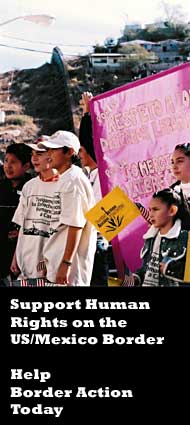It's one of the main causes of the diaspora of Mexican and Central American people in search of a means of staying alive. Unless you understand how NAFTA and other so-called "free trade" agreements have affected both US citizens and Mexican citizens, you will be vulnerable to a lot of misinformation disseminated by interests organized specifically to make sure that you direct your anger where they want you to and not where it belongs.
Here's a brief summary of some of NAFTA's effects on US workers. Go here for more about that as well as for the facts on how NAFTA has affected Canadian and Mexican workers. You can see at a glance who benefitted and who is losing. Not surprising that those who are losing are also the main militia and minuteman and anti-immigrant constituency, is it? Unfortunately, they're shooting the wrong goose.
Growing trade deficits with Mexico and Canada have displaced production that supported 1,015,291 U.S. jobs since NAFTA took effect in 1994 (see Table 1-1b).
Contrary to the rhetoric of most government officials and economists, industries that compete with imports from Mexico pay 1% to 5% more than export jobs (see Table 1-4 and Appendix Table 1-A1). This result is quite robust, and is confirmed with six different methods for computing average, trade-weighted wages. [This caused a drop in wages for US workers in related jobs.]
Workers with at most a high school education were particularly hard hit by growing trade deficits—they held 52% of jobs displaced; these workers make up 43% of the workforce.
Most of the jobs displaced by NAFTA trade deficits are in the manufacturing sector, which employs a higher share of such workers than any other major industry (see Table 1-5).
NAFTA displaced into lower-paying jobs 523,305 workers with a high school degree or less.
Men, who make up 55.2% of the labor force, lost 649,048 job opportunities, or 63.9% of total jobs displaced due to NAFTA deficits.
Women, who make up 47.8% of the labor force, were especially hard hit by rising imports in apparel: they lost 34,855 job opportunities, 67% of all positions displaced in the apparel sector.
The 1 million job opportunities lost nationwide are distributed among all 50 states and the District of Columbia, with the biggest losers, in numeric terms: California (-123,995), Texas (-72,257), Michigan (-63,148), New York (-51,582), Ohio (-49,886), Illinois (-47,701), Pennsylvania (-44,173), Florida (-39,987), Indiana (-35,157), North Carolina (-34,150), and Georgia (-30,464) (see Table 1-2).
The 10 hardest-hit states, as a share of total state employment, are: Michigan (-63,148, or -1.4%), Indiana (-35,157, -1.2%), Mississippi (-11,630, -1.0%), Tennessee (-25,588, -0.9%), Ohio (-49,886, -0.9%), Rhode Island (-4,482, -0.9%), Wisconsin (-25,403, -0.9%), Arkansas (-10,321, -0.9%), North Carolina (-34,150, -0.9%), and New Hampshire (-5,502, -0.9%) (Scott 2005, Table 1-3).
NAFTA is a free trade and investment agreement that provided investors with a unique set of guarantees designed to stimulate foreign direct investment and the movement of factories within the hemisphere, especially from the United States to Canada and Mexico. Furthermore, no protections were contained in the core of the agreement to maintain labor or environmental standards. As a result, NAFTA tilted the economic playing field in favor of investors, and against workers and the environment, resulting in a hemispheric "race to the bottom" in wages and environmental quality in the United States, Canada, and Mexico.
Sound familiar?



















0 comments:
Post a Comment